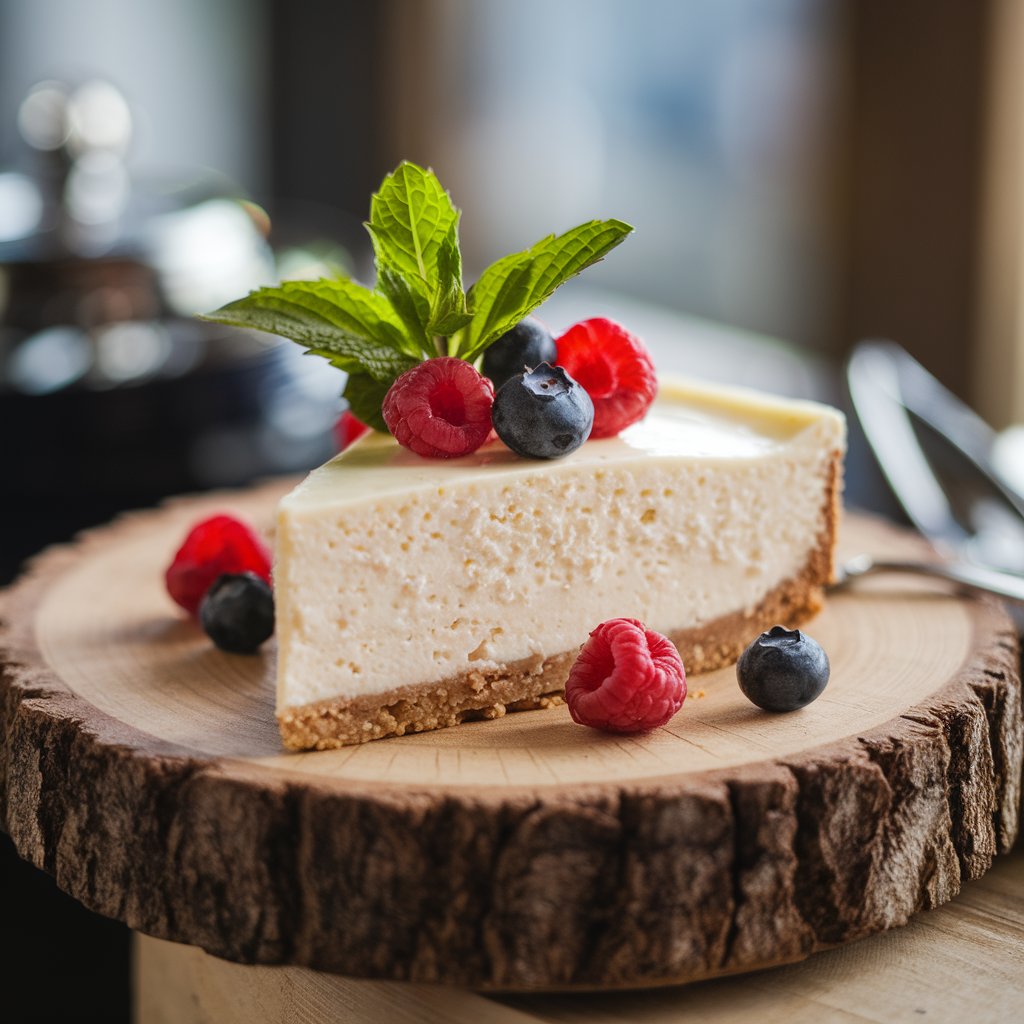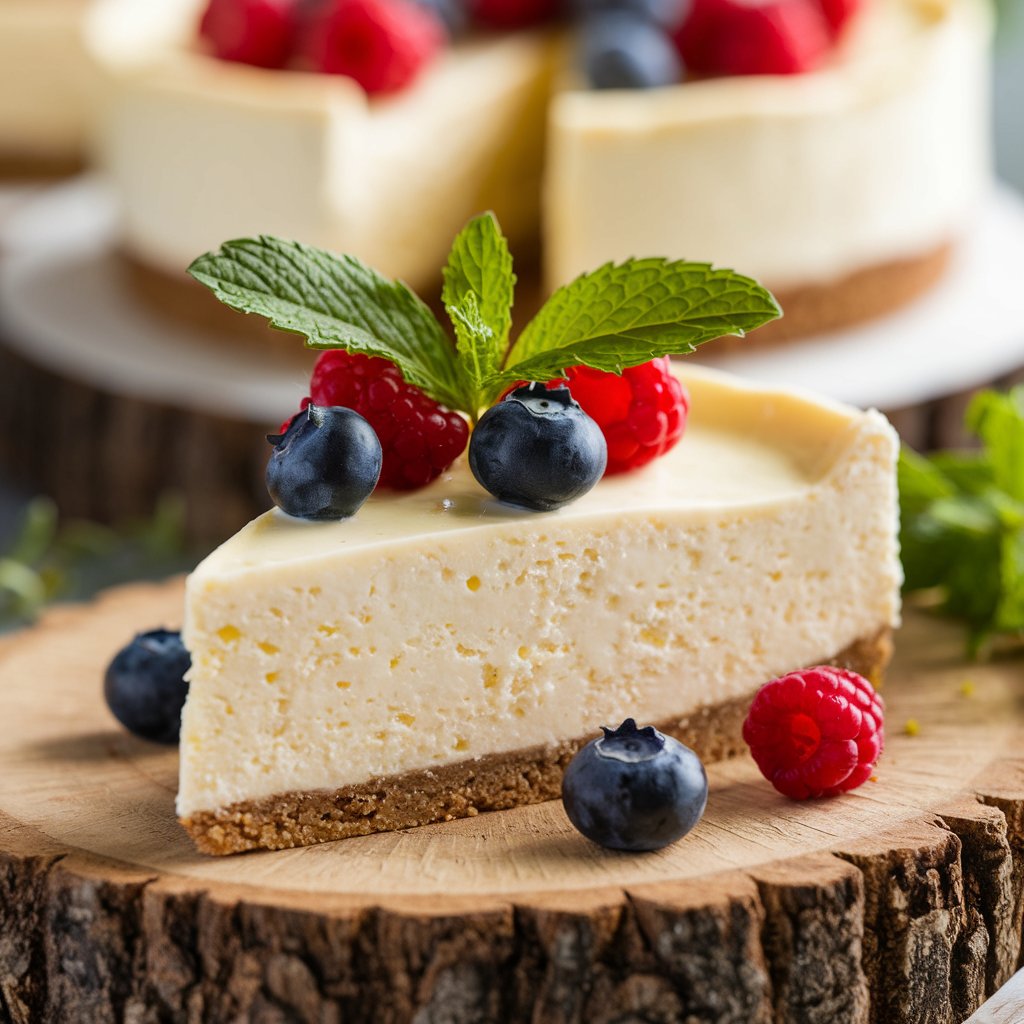Introduction
Who doesn’t love cheesecake? It’s rich, indulgent, and oh-so-satisfying. But traditional cheesecake often comes with a hefty side of guilt—loaded with calories, sugar, and fats. Enter cottage cheese cheesecake, the perfect compromise between decadent flavor and wholesome nutrition. Whether you’re a dessert lover seeking a healthier option or someone trying to spice up their diet with a creative twist, this cheesecake will soon become your go-to treat. 🍰
Imagine a dessert that’s creamy, luscious, and melts in your mouth but is also packed with protein and low in calories. Sounds too good to be true? Not anymore! Cottage cheese cheesecake is here to change the game.
Table of contents
What is Cottage Cheese Cheesecake?
Cottage cheese cheesecake is exactly what it sounds like—a cheesecake made primarily with cottage cheese instead of the usual cream cheese. It delivers the same rich texture but with significantly fewer calories and fats. Think of it as the health-conscious cousin of your classic cheesecake.

Why Cottage Cheese Over Cream Cheese?
Cottage cheese is a nutritional powerhouse. Compared to cream cheese, it’s lighter, loaded with protein, and much lower in fat. Plus, its mild flavor blends beautifully with sweeteners, making it a versatile base for desserts.
Blockquote:
*”Switching cream cheese with cottage cheese doesn’t mean compromising on taste. It’s like swapping your comfy sneakers for stylish yet cozy flats—better for you and still fabulous!”_
Cottage cheese cheesecake might sound unconventional, but once you take a bite, you’ll understand why it’s taking over dessert menus everywhere.
Instructions:
If you’re ready for the next part, let me know! 😊
Health Benefits and Ingredients for Cottage Cheese Cheesecake
The Health Benefits of Cottage Cheese Cheesecake
Who knew desserts could be both indulgent and good for you? Cottage cheese cheesecake brings together the best of both worlds. Let’s dive into the health benefits that make this dessert a star player in guilt-free indulgence.
Low-Calorie Advantage
One of the biggest perks of using cottage cheese is its low-calorie profile. Unlike traditional cream cheese, which is dense in calories and fat, cottage cheese offers a much lighter alternative. This makes cottage cheese cheesecake ideal for anyone keeping an eye on their daily calorie intake while still craving a creamy dessert.
To give you an idea:
- Cream Cheese (1 cup): ~800 calories
- Cottage Cheese (1 cup): ~200 calories
That’s a whopping difference, right? Now you can enjoy a slice of cheesecake without fretting over the calorie count. 🎉
High Protein Content
If you’re on a fitness journey or simply looking to boost your protein intake, cottage cheese cheesecake is your best friend. Cottage cheese is packed with casein protein, which digests slowly and keeps you feeling full longer.
Here’s how it stacks up:
- Protein in Cream Cheese (1 cup): ~7 grams
- Protein in Cottage Cheese (1 cup): ~28 grams
That’s almost four times the protein in a single serving! 💪
Suitable for Special Diets (Keto, Gluten-Free)
Cottage cheese cheesecake can be tailored to fit various dietary preferences:
- Keto-Friendly: By using sugar substitutes like stevia or erythritol and an almond flour crust, this dessert becomes a perfect low-carb treat.
- Gluten-Free: Opt for gluten-free alternatives for the crust, like oat or nut-based flours, and you’re good to go.
- Low-Sugar: Natural sweeteners like honey, maple syrup, or monk fruit keep the sugar content minimal.
Blockquote:
*”Cottage cheese cheesecake proves that desserts don’t have to be cheat meals—they can be part of a balanced diet too!”_
Ingredients for Cottage Cheese Cheesecake
Now that we know why cottage cheese cheesecake is such a health hero, let’s talk about the essentials. The ingredients for this dessert are simple, accessible, and leave room for endless customization.
Key Ingredients: Cottage Cheese, Eggs, and Sweetener
- Cottage Cheese: The star of the show. Make sure to use a smooth, creamy variety. If your cottage cheese is too lumpy, blending it beforehand will create a silky texture for the cheesecake.
- Eggs: Essential for binding and creating that rich, custardy texture we all love in a cheesecake.
- Sweetener: Regular sugar works fine, but you can experiment with low-calorie options like stevia, erythritol, or even honey.
Optional Add-Ins for Flavor Variety
Want to make your cheesecake truly unique? Here are some great add-ins:
- Vanilla Extract: A touch of vanilla elevates the flavor profile.
- Zest: Lemon or orange zest can add a refreshing citrus kick.
- Spices: Cinnamon or nutmeg for a warm, comforting twist.
- Fruits: Fresh berries, diced mango, or even banana puree for natural sweetness.
Substitutes for Common Ingredients
Ran out of an ingredient? No worries! Here are some simple swaps:
- Cottage Cheese Substitute: Ricotta cheese works well if you’re out of cottage cheese.
- Crust Alternative: If graham crackers aren’t available, try digestive biscuits, crushed nuts, or even a no-bake oat crust.
- Dairy-Free Option: Use plant-based alternatives like almond or soy cottage cheese to make this cheesecake vegan-friendly.

Ingredients Checklist for a Basic Cottage Cheese Cheesecake
Here’s what you’ll need for a standard recipe:
- For the Filling:
- 2 cups of cottage cheese (blended for smoothness)
- 2 eggs
- 1/2 cup of your preferred sweetener
- 1 tsp vanilla extract
- For the Crust:
- 1 cup of crushed graham crackers
- 3 tbsp melted butter
- 1 tbsp sugar
And that’s it! A short list of ingredients for a dessert that tastes gourmet. ✨
Instructions:
When you’re ready, say “yes” to continue with the next part, where we’ll explore the step-by-step recipe and solutions to common baking challenges! 😊
Step-by-Step Recipe and Troubleshooting Common Problems
Step-by-Step Recipe for Cottage Cheese Cheesecake
Now that we’ve got the ingredients ready, let’s dive into the process of making this creamy, protein-packed dessert. Follow these simple steps to create a cottage cheese cheesecake that’s bound to impress!
Preparing the Cottage Cheese Mixture
- Blend the Cottage Cheese:
Start by blending your cottage cheese in a food processor or blender until it’s completely smooth. This step is essential to achieving a creamy texture. No lumps allowed! - Add Eggs and Sweetener:
Crack two eggs into the mixture and blend again until fully incorporated. Add your sweetener of choice—whether it’s sugar, stevia, or honey—and a splash of vanilla extract for extra flavor. - Taste and Adjust:
Always taste your filling before baking. Too sweet? Add a little lemon juice. Not sweet enough? Add a bit more sweetener.
Pro Tip: A pinch of salt enhances the sweetness and balances the flavors.
Crafting the Perfect Crust
- Choose Your Base:
Crush graham crackers, digestive biscuits, or use almond flour for a gluten-free option. - Mix with Butter:
Combine the crumbs with melted butter and a tablespoon of sugar (or a sugar substitute). Stir until the mixture resembles wet sand. - Press into the Pan:
Pour the crust mixture into a springform pan, pressing it down firmly and evenly with the back of a spoon. Bake it for 8–10 minutes at 350°F (175°C) to set it.
Blockquote:
*”The crust is like the foundation of a house—solid, dependable, and ready to support all the good stuff on top!”_
Baking the Cheesecake to Perfection
- Combine the Filling and Crust:
Pour your cottage cheese mixture over the pre-baked crust, spreading it out evenly. - Bake in a Water Bath:
Place the springform pan in a larger baking dish filled with hot water. This prevents cracks by maintaining even moisture and heat distribution. - Cook Until Set:
Bake at 325°F (160°C) for about 45–55 minutes. You’ll know it’s done when the edges are set, but the center jiggles slightly when shaken.
Cooling and Serving Tips
- Cool Gradually:
Turn off the oven and let the cheesecake sit inside with the door slightly ajar for 30 minutes. This prevents sudden temperature changes that can cause cracks. - Refrigerate:
After cooling to room temperature, refrigerate for at least 4 hours or overnight for the best texture. - Garnish and Serve:
Add toppings like fresh fruit, chocolate drizzle, or whipped cream before serving. You can also sprinkle some crushed nuts for an added crunch. 🍓
Common Problems and Solutions
Even the best bakers face hiccups. Here are the most common issues when baking cottage cheese cheesecake and how to fix them.
Why Did My Cheesecake Crack?
Cracks are usually caused by overbaking or rapid cooling.
Solution: Always bake your cheesecake in a water bath, and don’t skip the gradual cooling process in the oven. Avoid opening the oven door during baking—it’s tempting, but patience pays off!
How to Prevent a Watery Cheesecake
A watery cheesecake usually results from excess moisture in the cottage cheese.
Solution: Drain your cottage cheese thoroughly before blending. You can also use a cheesecloth to remove extra liquid.
Tips for Achieving the Perfect Texture
Texture issues often stem from underbaking or uneven mixing.
Solution: Ensure the filling is smooth and well-mixed before pouring it over the crust. Bake until the center jiggles slightly but isn’t runny. If in doubt, use a toothpick or thermometer (the internal temperature should be around 150°F or 65°C).
Blockquote:
*”Every cheesecake mishap is a lesson in disguise—because practice always leads to perfection!”
Creative Variations, FAQs, and Conclusion
Creative Variations of Cottage Cheese Cheesecake
Cottage cheese cheesecake is versatile and ripe for experimentation. With just a few tweaks, you can create unique versions of this delicious dessert to suit your cravings and impress your guests. Let’s explore some popular variations!
Chocolate Cottage Cheese Cheesecake
For chocolate lovers, this version is pure bliss.
- Cottage Cheese Dessert Recipes
- Tinys Mac and Cheese Recipe
- Tineke Younger Mac and Cheese
- Gordon Ramsay Chocolate Cake Recipe
- How to Make It:
Add 1/3 cup of cocoa powder to the cottage cheese mixture and blend thoroughly. You can also fold in chocolate chips for bursts of flavor. Top with a ganache drizzle after baking for a decadent finish. - Pairing Tip: Serve with whipped cream and a sprinkle of shaved dark chocolate for a touch of elegance. 🍫
Lemon Zest Cottage Cheese Cheesecake
This citrusy variation is refreshing and light—perfect for summer.
- How to Make It:
Add the zest and juice of one lemon to the filling mixture. A teaspoon of lemon extract can amplify the flavor. Garnish with thin lemon slices or candied lemon peels. - Pairing Tip: Pair it with a dollop of Greek yogurt for extra tanginess. 🍋
Berry-Topped Cottage Cheese Cheesecake
Fresh berries take this cheesecake to the next level, adding a burst of natural sweetness.
- How to Make It:
Prepare the basic recipe, then layer mixed berries (strawberries, blueberries, raspberries) on top after cooling. For added flair, brush the berries with a light glaze of honey or apricot jam. - Pairing Tip: Serve with a mint leaf garnish for a pop of color and freshness. 🍓
FAQs About Cottage Cheese Cheesecake
Got questions? We’ve got answers! Here are some common inquiries about making and enjoying cottage cheese cheesecake.
Can I Use Low-Fat Cottage Cheese?
Yes! Low-fat cottage cheese works wonderfully and helps keep the calorie count even lower. However, blending is crucial as lower-fat versions can sometimes be a bit grainy.
How Long Can I Store Cottage Cheese Cheesecake?
Properly stored, cottage cheese cheesecake can last up to 4–5 days in the refrigerator. Keep it in an airtight container to maintain freshness. For longer storage, freeze it for up to 3 months. Just make sure to thaw it overnight in the fridge before serving.
Can I Make It Without a Crust?
Absolutely! For a crustless version, simply pour the filling mixture directly into a well-greased springform pan. It’s a lighter, gluten-free alternative that doesn’t compromise on taste.
What’s the Best Way to Blend Cottage Cheese?
A high-speed blender or food processor works best for achieving a smooth texture. If you don’t have one, pass the cottage cheese through a fine-mesh sieve for a similar effect.
Can I Add Nuts or Seeds to the Cheesecake?
Definitely! Adding crushed nuts or seeds to the crust or sprinkling them on top before serving adds a delightful crunch and extra nutrients.
How Do I Know When My Cheesecake Is Done?
The cheesecake is ready when the edges are set, but the center jiggles slightly when you shake the pan. Overbaking can lead to cracks, so keep an eye on it during the final minutes of baking.
Conclusion
Cottage cheese cheesecake is proof that you don’t have to choose between indulgence and healthy eating. With its creamy texture, high protein content, and endless flavor possibilities, it’s a dessert that fits into nearly every lifestyle. Whether you stick to the classic recipe or get adventurous with variations like chocolate or citrus, this cheesecake will have you and your loved ones coming back for more.
So, what are you waiting for? Grab some cottage cheese and give this recipe a try. Once you’ve had your first slice, you’ll wonder why you didn’t discover it sooner. 😊
Cottage Cheese Cheesecake: The Creamy, Guilt-Free Dessert

